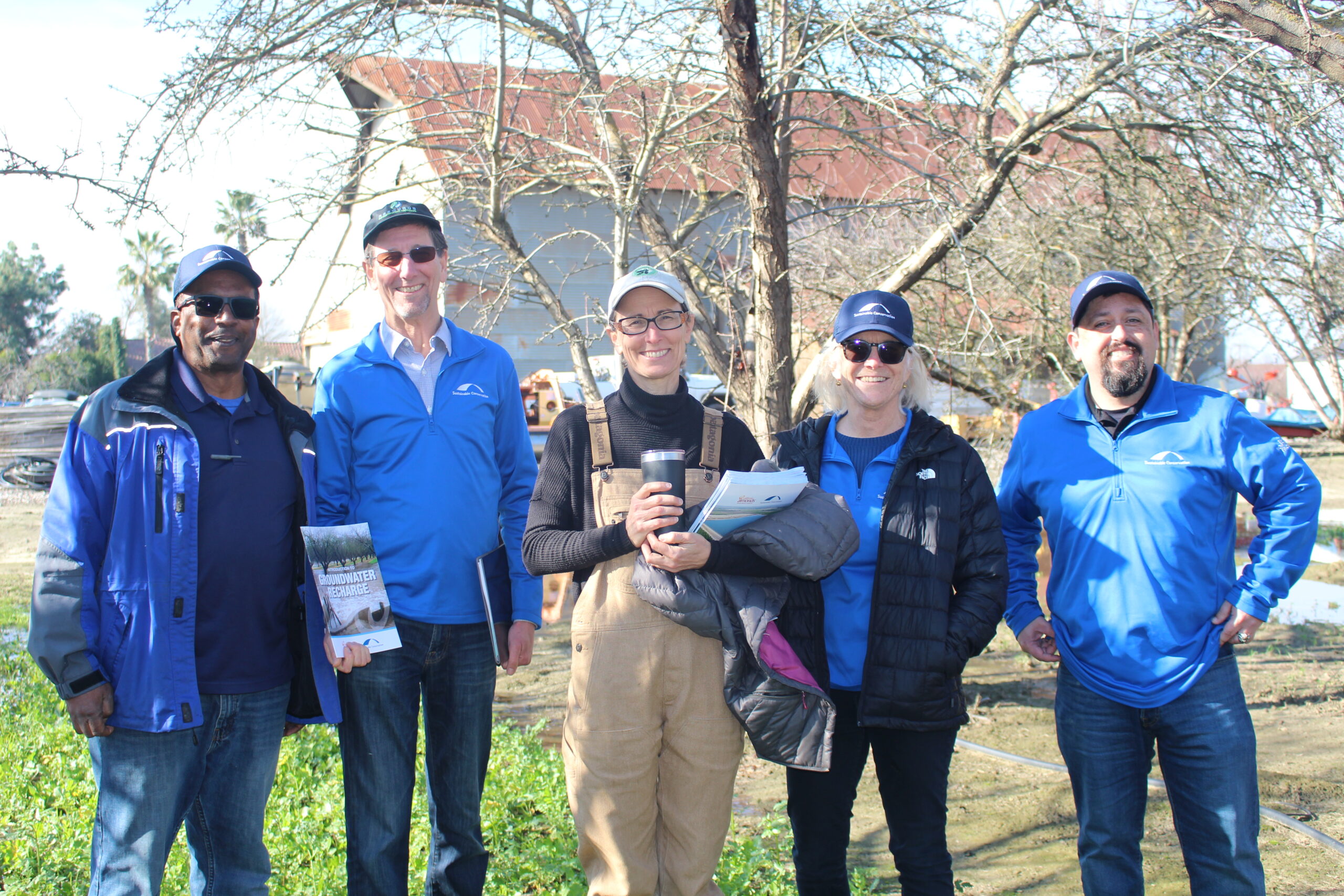
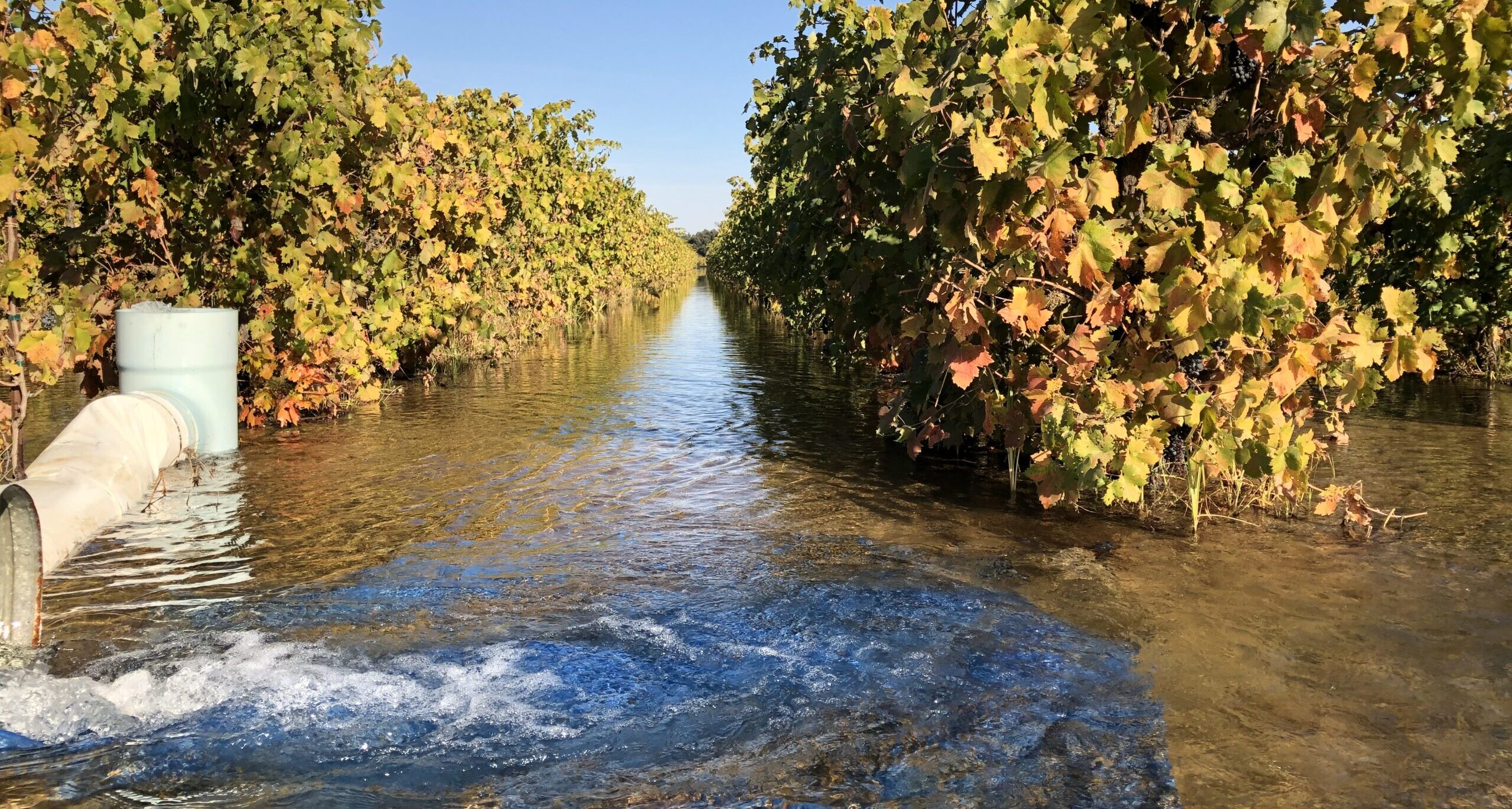
A Watershed Moment Interview Series
We’ll feature four conversations with groundwater recharge proponents across the state. First up is almond grower Christine Gemperle.
Christine Gemperle is a second-generation almond grower and a passionate advocate for sustainable agriculture. Continuing her family’s legacy of almond farming, she co-founded Gemperle Orchards in California’s Central Valley with her brother Erich. With a focus on transparency, Christine engages with consumers, shares her farming experiences, and advocates for agriculture’s crucial role in combatting climate change and paving a sustainable water future. Her dedication makes her a vital ally for the future of farming in the Central Valley.
For a more in-depth bio on Christine, read her feature by Allies for Agriculture!
Can you tell us a bit about your family’s farming history in the Valley?
Christine Gemperle (CG): My dad was an immigrant. He came to the United States from Switzerland in the mid-sixties. He and his brother started a poultry and almond operation, so I grew up in that, as did my brother [Erich Gemperle,] who is my business partner. I went off to college to study fisheries, and Erich went to welding school.
After that, I figured out that I wanted to come back and farm, so Erich and I became partners and started our own operation, separate from my dad’s. But my dad was always our mentor.
I have a masters in fisheries. Go figure, right? I worked on salmon in the Stanislaus and Tuolumne Rivers. When I first moved back here, I thought I’d be able to do both.
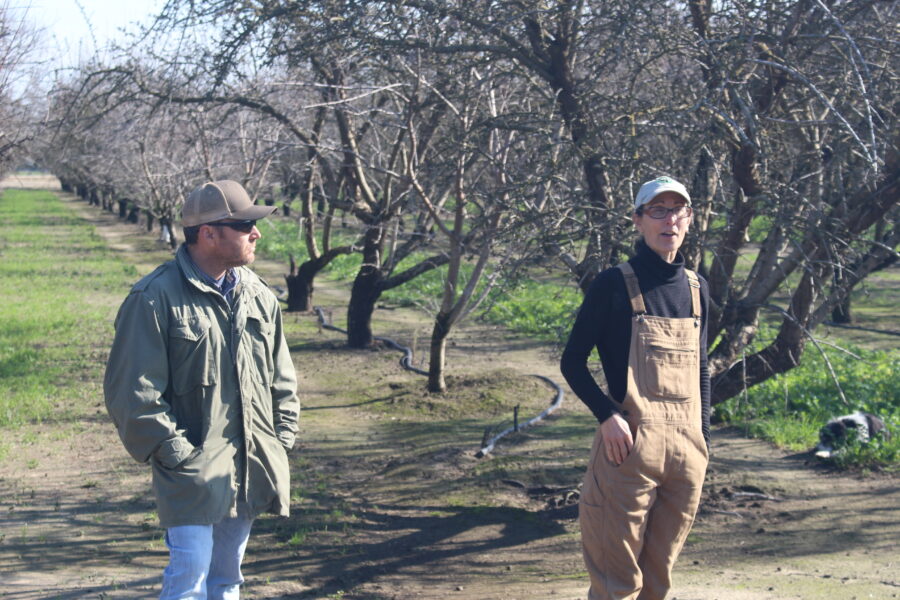
Erich and Christine Gemperle on their farm
So, you have the environmental and biology background to inform what you do every day.
CG: It does, a hundred percent.
What drew you to farming, and what keeps you doing it?
CG: Well, of course, I like being outside. I wasn’t meant to be a desk person. But I also like the stability we have, in some ways. You’re doing the same thing every year because it goes by the biology of the trees, or whatever crop you’re growing. But at the same time, every day is different. You have these patterns that you follow, but not in such a way that it gets boring, ever. And there’s always a problem to solve.
Even when I was a kid, I liked word problems and problem-solving on tests. I also like diagramming sentences.
Breaking stuff down and understanding how it works.
CG: Pretty much. I like to know how things work.
What first made you decide to try groundwater recharge?
CG: Because I’m on the Almond Board [Of California,] I knew about the studies they were conducting. I know what it’s like to have hardship in a water-compromised area. I’m always thinking about how we can conserve better, and how we can save our water. That’s always at the forefront of my mind.
I thought, “why not do it where I can do it,” because it’s important! I’ve watched the water supply arguments and roadblocks and challenges for years. I’m going to do something. Maybe it’s just little me, but maybe it grows into something bigger and greater.
Speaking of trying new things, tell me about your cover cropping and why you decided to try the practice.
CG: That was a no-brainer. About 10 years ago, I was introduced to the Seeds for Bees program, and I serve on their board now. This is also when colony collapse was huge, and nobody knew what was going on – we were worried that we might not have bees. And I thought initially that I could do something that makes the bees at my place healthier and gives my beekeeper a leg up.
But then I saw all these other benefits, and we learned a lot about the infiltration rates and soil health and the microbial community, and then beneficial insect populations. And now we’re learning even more about how cover cropping doesn’t necessarily take more water. In fact, it might keep your orchard cooler and reduce evaporation rates. A UC Davis researcher is doing that work right now on our property.
How’d you get in touch with Sustainable Conservation?
CG: Turlock Irrigation District (TID) put me in touch with you. We were having these storms [in December and January], and my property is right on the canal. I could see the water flowing out to the river. I knew recharge could be done. I got in touch with TID to see if I could take some of the water – I knew the sandy soil on my property was perfect, and so is the way we have our orchard set up (how it’s leveled, how water can’t really run off, our permanent levees.)
And it was dormant. We had finished our winter work. We had gotten all our jobs done and planted the cover crop seed, for the second round of cover crop. TID moved fast, got the telemetry they needed and got us set up, and Rogell [Rogers] came out to do the soil samples. We pretty much made it happen within a week. It was great. Stars aligned.
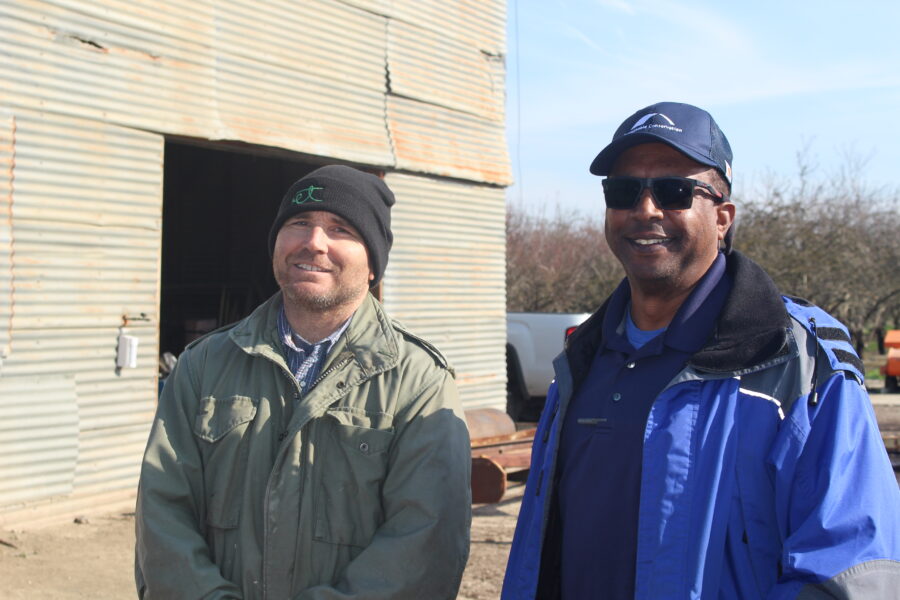
Erich Gemperle and Rogell Rogers (sneak peek of a future Interview Series feature!)
What role do you think agriculture plays – and can continue to play – in California’s long-term water sustainability picture?
CG: Ag lands are the key to a lot of solutions for climate change problems. If we’re able to take on a lot of that excess water during these storm and flood events, we could prevent it from going downstream to flood communities. And at the same time, we’re recharging the aquifers and helping the communities around us as well. And, it can be good for the soil, too.
There’s a lot of opportunity. We plant cover crops, we sequester carbon, we recharge groundwater – but it does become a pinch point in the larger narrative. There needs to be a better appreciation for – and, really, compensation or incentive for – these practices. Growers are often willing to try things, but our budgets may not allow it.
These practices add to our budget, and there’s often not a direct financial return – aside from the environmental benefits. As of yet, there’s not a lot of people paying more for your almonds because you did the right thing.
It’s also time. When I was doing that recharge, I was basically working for three days straight. That just didn’t happen by itself. I had to be there, I had to monitor it, I had to go out in super stormy weather. That was work.
The same goes for cover cropping and whole-orchard recycling. These are all things that come with a time cost. And our time is already so jam-packed, it’s hard to fit in all the jobs that we do.
How can we address these challenges, and what are your hopes for the future?
We can think about how we can all share these burdens — grant programs, or tax-payer or beneficiary money to help growers make these changes. Our little old flood canal really needs rehabilitation if we’re going to keep using it like this. I can’t put that much pressure on it, or use it that often, and expect that it won’t have a blowout at some point. But I don’t have the money to fix it.
Like I said, farmers are often willing, but they also often don’t have the resources, whether those be time or money. What we do here impacts our local community, yes, but it also impacts the state, and the nation. It’s not a small thing for California to not be producing.
I hope this is something that a lot of growers want to get on board with. Farmers are cautious people, and sometimes it takes a little convincing, somebody else trying something. But as soon as they see a good result, they’re so in.
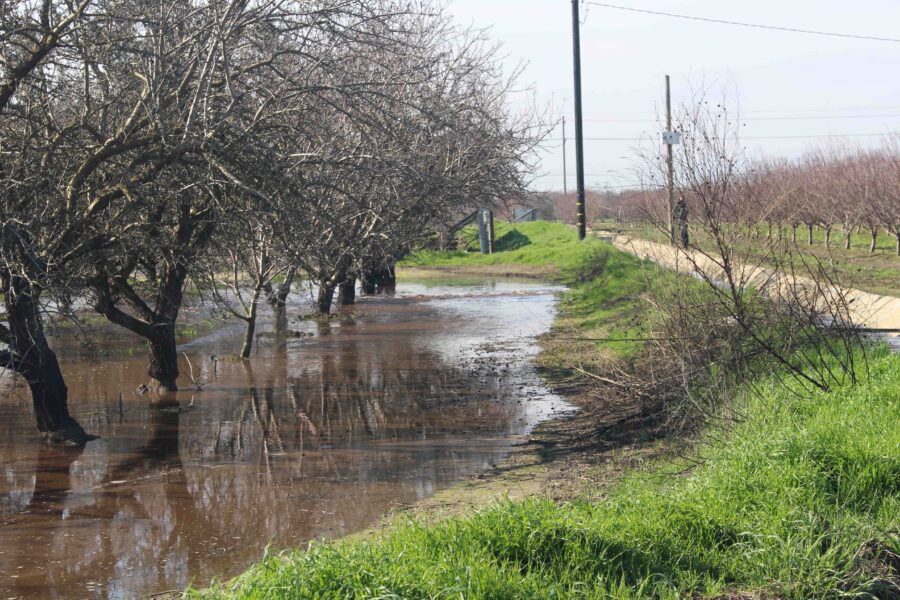
Flooded orchard row on the Gemperle property. Recharge in action!
To wrap, we have a very important question: what’s the story behind the TIE Fighter in front of your property?
CG: Erich built it a couple years ago. He’s a fabulous welder, and he loves Star Wars. It’s about 4,000 pounds, it lights up, the hatch opens, and you can sit in it. He built a special trailer to transport it and made sure it fits under the overpasses and won’t hit any lights or trees or anything. He built it originally for a Turlock Christmas parade, and of course he won – how could he not?
He brought it to May the 4th Be With You in downtown Modesto one year, too. That was a hit.
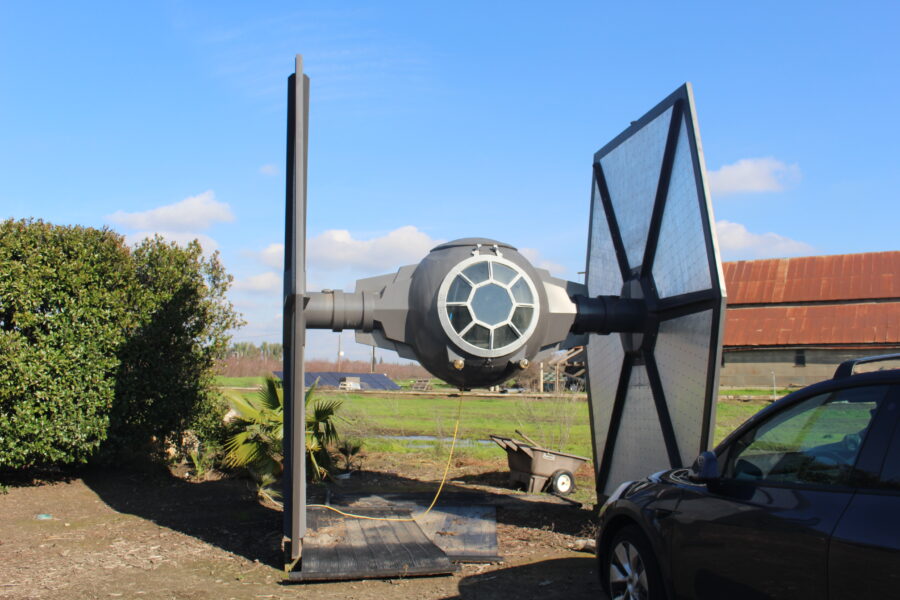
Erich Gemperle’s award-winning TIE fighter replica
Stay tuned for the other three conversations in our fall interview series. We’ll speak with two water managers on what it takes to prep for flood and drought, Sustainable Conservation Agronomist Rogell Rogers on the ins and outs of recharge on the ground, and Director of Resources Stewardship Daniel Mountjoy on the future of our watershed work.
